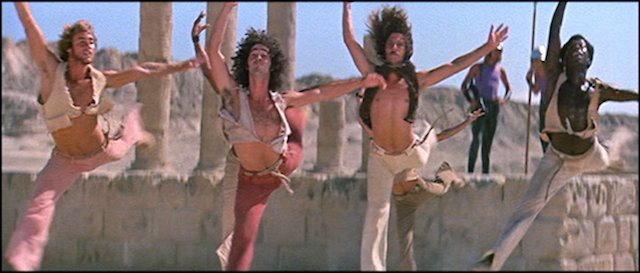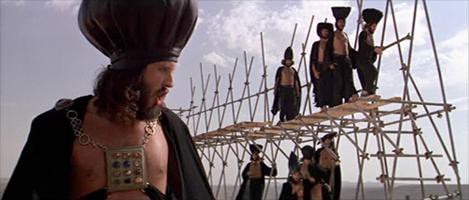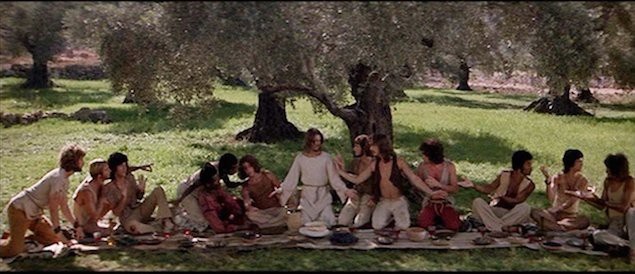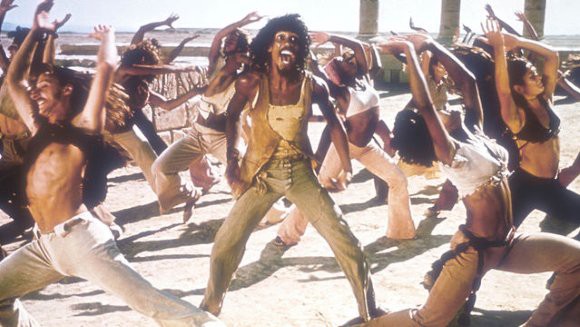A Campy Pirouette and A Scissor Leap: An Appreciation of Jesus Christ Superstar
by Laura Snelgrove

Let’s get the obvious out of the way immediately: Jesus Christ Superstar is the greatest film of all time.
Growing up, I looked forward to Easter for two reasons: candy, and our annual Good Friday JCS screening. My immediate family at the time was composed of one serious Catholic, one agnostic, and me, a bizarre child so obsessed with Christianity that I insisted on dressing as a semi-obscure Biblical character for Halloween (it was Miriam, sister of Moses). This movie — the 1973 Norman Jewison-directed cinematization of Andrew Lloyd Weber and Tim Rice’s rock opera based on the last days of Jesus Christ — was our favorite, and remains so to this day, in spite of the fact that the same people are now, respectively, a post-Catholic, an agnostic, and an atheist who believes in astrology and ghosts. While it’s still nice to mark the passing of another year with a Good Friday viewing, the movie’s true power has little to do with Jesus or the Christian holidays and everything to do with the transcendent possibilities of film, music, and badass postmodern costuming.
JCS is not a religious film exactly, even though its lyrics are carefully adapted from scripture, in part because of the very sympathetic portrayal of some characters’ creeping doubt that the protagonist is actually the “son of God.” Instead, it’s a celebration of Jesus’ story on its own merits as a defining cultural myth and a cautionary tale about authority, trust, and ego that leaves the burden of real faithfulness to the viewer. This is why the movie can be just as powerful a secular story as a religious one. The film’s costumes are a fabulously anachronistic mash-up of “period” dress (interpreted via the traditions of European religious art) and 1970s American counterculture styles, and this indifference to so-called “accuracy” drives home the point of the movie, which is that the story is universal, whatever you believe.
Though JCS was a play before it was a movie, the movie’s visual are most enduring because no stage production can ever reach as many people as the film already has. And it has reached, and deeply touched, a lot of people; I once spoke to Ted Neeley (the actor who played Jesus) on the phone, and he described his life as essentially having had to conform to near-Jesus-like standards of behavior, lest he break the spell his performance has cast on two generations and counting.
Jesus Christ Superstar glories in a postmodern embedding of history in the present, visually collapsing time and space to tell its story in a way that’s religion-neutral and yet essentially spiritual. It is an ancient folk tale told through classic rock and far-out 70s slang, the grandest of grand old narratives bent to fit a very modern form, perfectly of its time though set 1,940 years earlier. The challenge facing costume designer Yvonne Blake was how to match the perfectly po-mo pastiche of Lloyd Webber and Rice’s music and lyrics with the dress of its large, rambling ensemble cast. Many of the costumes are what would now be called “ironic,” a sartorial wink in the direction of what’s expected followed by a campy pirouette and a scissor leap off in the opposite direction (and maybe a back handspring and some jazz hands thrown in for good measure). Yet somehow all that parody and play never demeans or mocks, allowing instead just enough breathing room for reverence.

The film opens on a painted school bus barreling through the dusty hills of Avdat, Israel, stopping to let out its motley crew of passengers — a few dozen hairy, lanky, Westerners in tank tops, bell bottoms, yellow-lensed sunglasses, and horrible hats. We familiarize ourselves with their faces as they unpack the bus full of gear, and slowly, ritualistically, transform themselves into versions of the characters who birthed our modern archetypes: Judas the two-faced best friend, Mary Magdalene the hooker with a heart of gold, Caiaphus the power-hungry middle manager who sells his own people out to the oppressor, and blond, blue-eyed Jesus the original and eternal martyr.
The film’s having been made on location is one of its greatest strengths, and also likely why all subsequent stage productions feel so corny. Placing the actors amid the mountains and canyons in which their source material is set collapses those two intervening millennia — their sweat, unkempt facial hair, and dusty bare feet provide a sense of authenticity that allows the costumes to take us on further flights of fancy. The apparently unchanging, eternal nature of this setting grounds the story in real human history. Whether or not you believe that the story being dramatized really happened, you know it would have happened right here. It would have looked at least a little like this.
For her part, Blake embraced the opportunity to match this physical authenticity with the costuming of certain characters. Some of the company (Jesus, Mary Magdalene, Pontius Pilate) are dressed in reasonable facsimiles of ‘Biblical-age’ draping and robes in plausibly ancient-looking colors, presumably naturally dyed, including oranges, yellows, and browns, as well as white (for Jesus, of course). Others, including most of the disciples, wear a hybrid between this imagined antiquity and the clothes the actors rode in on, giving them the appearance of having just wandered out of a potluck dinner party at my parents’ house c. 1977. Brown bell bottoms and jean shorts, leather sandals, vests, tunic tops with lacing undone to expose reams of sun-kissed chest hair.
In other scenes, actors portraying sex workers, drug dealers, and gamblers wear contemporary fishnet stockings, bejeweled bras, platform boots, army surplus jackets, and Outback hats. Still others, particularly King Herod and his courtesans and the angels who sing back-up for Judas in the final scene’s hybrid heaven-hell-nightclub-cave, wear sensational, fantastical sequin bombs out of a disco nap fever dream. As always, the bad boys and bad girls get to wear the fun clothes and do the sexy dancing, while the virtuous kids have to make it home for supper.

But JCS is also the story of a minority ethnic group fighting for its territory against a foreign colonizer and the evils of proxy governance by a native elite. The power in the hands of the local high priests’ council is conveyed by some of the film’s most wonderful (and Halloween-able) costumes: dramatic black capes worn over bare chests, with their internal hierarchy signaled by the size and variations on the shape of their black hats, which range from jauntily cocked anvil to exaggerated quadri-corne to inflated condom. The big boys even get to wear a bejeweled square breastplate nestled between their glistening pecs. Their dark sexuality just oozes corruption and villainy. Meanwhile, the hordes of Jesus’ followers are perfectly scruffy and multi-ethnic, dancing ecstatically in the desert in the familiar grungy gear (fringed vests, rope belts, waving scarves) that screams Haight-Ashbury and Hair, with echoes in the Arab Spring, Occupy, et al — the put-upon masses demanding to be heard.

So Lloyd Webber, Rice, and Jewison’s political sympathies are spelled out clearly by their portrayals of the Israelites, their corrupt clergy, and their Roman overlords. But it’s Jesus’s rough white linen dress that makes their interpretation of the Jesus myth clear: it’s humble and simple, pure and clean, asexual. It is not cool or kingly, and it fits any of the images we may have in our heads of a shepherd from 33 AD, the haloed subject of a Renaissance fresco, or a beardy weirdy tripping balls in Washington Square Park. But, unlike the trousers worn by the sinners and strivers around him, the dress shackles Jesus below the knee. He can’t run, and every time he tries, he stumbles and falls. Whether he is indeed the son of Jehovah or an insane person is irrelevant, because he is everyone whose sense of duty has kept them from running free. Jesus is just the guy whose dad pressured him into law school, he’s the closeted mama’s boy, the frustrated artist paralyzed by dogmatic ideas of authenticity.
The film’s costumes do more than just support the playful postmodernism of the music and lyrics. In their embrace and exaltation of dress across two millennia, they speak the essential message of the piece itself — that it doesn’t matter whether or not the story of Jesus is true, per se, only that its archetypes, melodramas, messages, and warnings endure. It is this generous, non-judgmental approach to the story that allows the film to speak to me as deeply and truly now as it did so many years ago when I believed in the details with all of my strange little Christian heart. I may now choose to see the divine in things like friendship and grassroots social movements and getting stoned and doing crafts, but I will always see it in Jesus Christ Superstar.
Laura Snelgrove is a fashion scholar currently on baby hiatus in New York City.